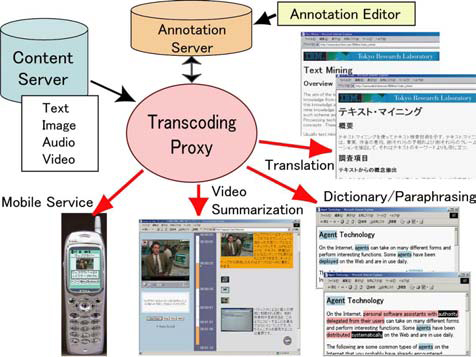Comprehensive List of Researchers "Information Knowledge"
Department of Media Science
- Name
- NAGAO, Katashi
- Group
- Intelligent Media Engineering Group
- Title
- Professor
- Degree
- Dr. of Engineering
- Research Field
- Content technology / Agent technology / Artificial intelligence / Robotics

Current Research
Intelligent Agents, Contents, Personal Robots, and Vehicles
OUTLINEMy research interests include digital content technology such as authoring, retrieval, transformation, and the distribution of digital content and intelligent agent technology including natural language understanding and generation, multimodal interaction, and the learning and adaptation of agents and robots. I have a strong interest in the integration of physical and informational environments, considering barrier-free and safety, based on personal intelligent vehicles and the infrastructures around them.
TOPICS
(1) Intelligent Agents - Agent Augmented Reality -
We have developed intelligent agent technology called Agent Augmented Reality capable of the augmentation of our real world environment by actively integrating information worlds. We also introduced a special agent called a real world agent. A real world agent is a software agent who can support the user in performing tasks in real world environments, such as place to place location guidance, instruction in physical tasks, and the augmentation of human knowledge related to the physical environment. For the agent to achieve these tasks, he needs to be aware of the user's real world situation. The detection of real world situations is performed through the integration of various methods, including location awareness using a global positioning system, object recognition through machine-recognizable IDs, and processing visual/spoken inputs. Real world agents can detect real world situations, interact with humans, and perform tasks in information space. Agents also work as facilitators of human-human communication because they can exchange information on their users' current situations so that the users can be mutually aware of their contexts.
(2) Intelligent Contents - Semantic Transcoding -
Traditionally, Web content has been created using only "human-friendly" information. However, with the continuing explosion of Web content, I argue that content should be created in a more "machine-friendly" format. We propose a system to annotate documents externally with additional information to simplify them for computers to process. We have developed a system for semi-automatic and interactive Web document annotation that allows users to annotate any element of any Web document with additional information. We have also developed a proxy server that transcodes requested contents using information from annotations assigned to them. All types of annotation are described using Extensible Markup Language (XML), which is the standard for interoperable data exchange systems. The entire process is called "semantic transcoding," because it provides a means to easily transcode annotated documents using information about their deep semantic content. Current semantic transcoding processes mainly handle text and video summarization, language translation, speech synthesis of documents containing text and images, and client device-dependent adaptation of online contents, as shown in the figure.
(3) Personal Intelligent Vehicles - Attentive Townvehicle -
Extending the concept of mobile or wearable computing opens up a new field of human-centered computing called Mountable Computing, which supports not only anytime/anywhere computing functionalities but also computer-augmented physical movement and transportation activities. While current Intelligent Transportation Systems (ITS) do not deal with services for small personal vehicles (motorcycles, electric wheelchairs, and bicycles), we are studying physical and information infrastructures to make such small vehicles intelligent enough to contribute to a physical/digital barrier-free society. We also designed and developed a new electric personal vehicle called the Attentive Townvehicle (AT). AT is a human-centered and context-aware vehicle that makes people's urban lives more comfortable and enjoyable. AT also contributes to the integration of physical and informational environments and human community activities both in the real world and cyberspace.

Figure : Overview of semantic transcoding
Career
- Katashi Nagao received his Ph. D. in Computer Science from the Tokyo Institute of Technology in 1994.
- He was a researcher at IBM Research, Tokyo Research Laboratory from 1987-1991 and 1999-2001 and at Sony Computer Science Laboratories, Inc. from 1991-1999.
- Since 2002, he has been a professor at the Center for Information Media Studies, Nagoya University.
Academic Societies
- JSAI
- IPSJ
- IEEE
Publications
- Digital Content Annotation and Transcoding, Artech House Publishers (2003).
- Annotation-Based Multimedia Summarization and Translation, Proc. of COLING-2002, pp. 165-177 (2002).
- Semantic Annotation and Transcoding : Making Web Content More Accessible, IEEE MultiMedia, Vol. 8, No. 2, pp. 69-81 (2001).








